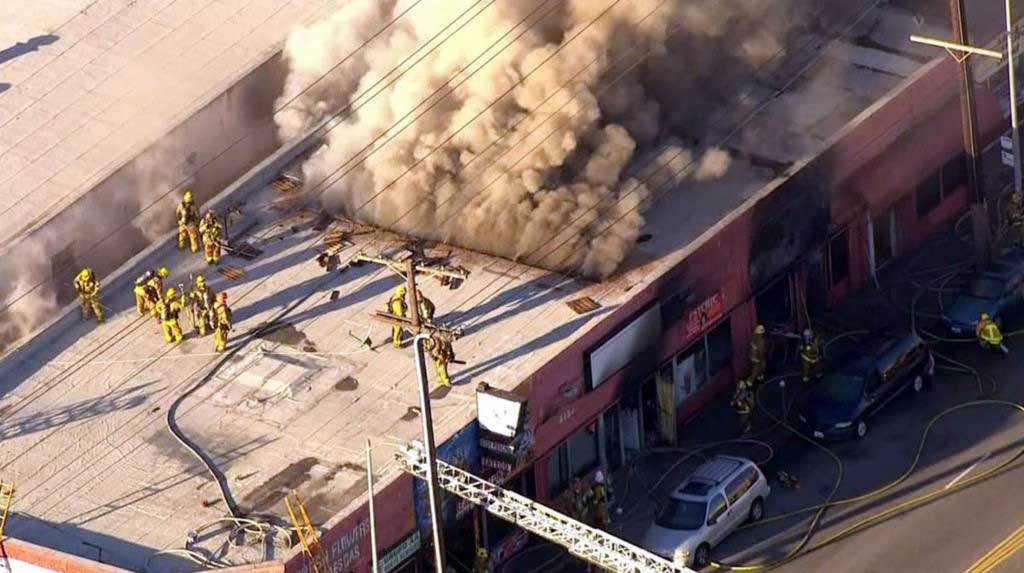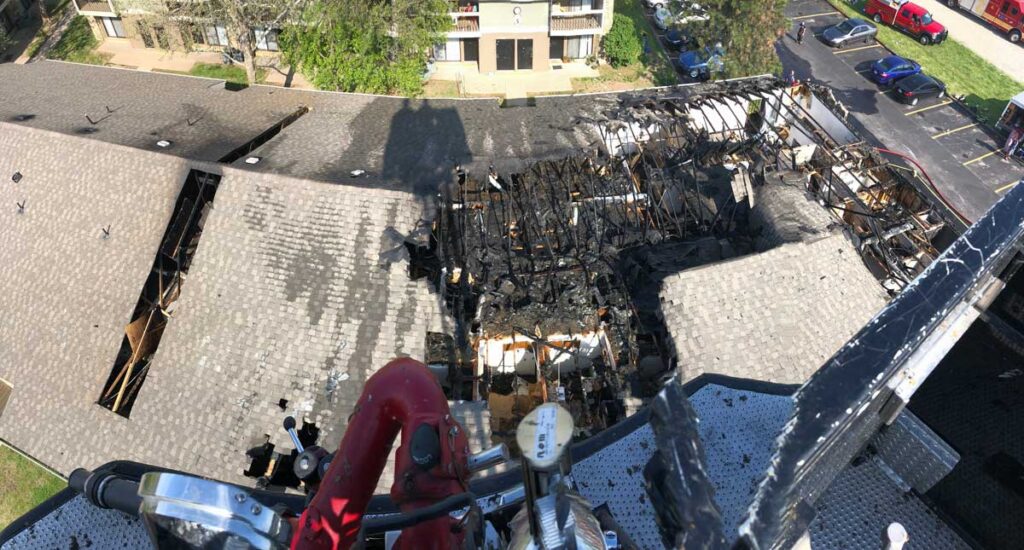
By Ed Hadfield
As a result of the nation’s housing crisis, we are seeing a rapid rise in multifamily dwellings. Developers are leaning toward the development of large, multistory housing complexes with large, open attic spaces often unprotected by fire protection systems adequate to stop a deep-seated fire from spreading rapidly across the entire complex. These mixed-use buildings include the rapid proliferation of buildings commonly referred to as “5 over 1” construction. This means the structure is five stories in height and built over a concrete platform. The first floor usually consists of commercial space, individual parking garages, or a larger parking lot.
- A New Challenge: The Millennium Box
- Ventilating Lightweight Roof Assemblies: The Inverse Trench Cut
- Pressler: Ventilating Flat Roofs
- Flat-Roof Operations: From the Street to the Roof and Back
The buildings may be different, more complex, and made from different materials, but the challenges facing the fire service remain constant. According to FEMA statistics from 2017-2019, an annual average of 106,700 fires occurred in multifamily residential buildings. These fires caused on average 400 deaths, 3875 injuries, and 1.7 billion in property loss. In 2020 to 2022 nationwide there was a sharp 15% increase in these fires.
When we look at the historic property loss data, multifamily residential and large commercial buildings account for the highest dollar loss percentages. These two structure types also account for the largest percentage of displaced residents and workers, as well as the biggest economic impact on a community.
‘Roof Division’ and Interior Crews
One of the problems with combating these large void space fires is the ability to manage the rapidly advancing fire in the overhead by crews assigned to the roof to perform vertical ventilation. As an incident commander (IC), keep in mind that these challenging fires require a large commitment of personnel. One cornerstone of the fireground that cannot be overlooked is the roof. First and foremost, the IC must fully understand the building has seven sides: Alpha, Bravo, Charlie, Delta, sub (basement), interior, and roof. Ideally, when deploying resources, the IC can capture all seven sides. A critical element of truck company duties is to evaluate the roof while the interior companies advance hoselines and locate the seat of the fire. The ability to coordinate companies on the roof with interior companies is the hallmark of offensive fire attacks.
Further, large void space roofs will present a challenge in attempting to be both offensive in placing your heat holes. They may also compel you to be defensive in the placement and size of your defensive strip ventilation opening. While some refer to this as a “trench,” the placement of a defensive strip ventilation opening is in conjunction with offensive ventilation operations and works to stop the rapidly advancing fire in the overhead. This allows interior personnel to aggressively work below in an area that is not susceptible to collapse, thus allowing interior crews to extinguish the fire while continuing to search all attainable searchable spaces.
For years, discussion has centered around the placement of the defensive strip opening. Some will say the strip should be on the uninvolved side of the structure or firewall. This is incorrect. First, we look at the sequential steps and operations of what the “roof division” is attempting to accomplish. The primary goal is to remove as much heat and fuel from the interior of the occupancy as possible. This will allow interior crews to rapidly deploy hoselines in an aggressive manner, to stop the fast-advancing fire while creating a tenable interior environment. This then allows enhanced visibility for search crews as they search all attainable search spaces within the occupancy. To accomplish this goal, crews assigned to the “roof division” must operate in an offensive manner, placing offensive heat holes over the fire or as close to the main body of fire as the roof stability will allow. Do this by creating “smoke indicator holes,” generally small triangular holes big enough to determine heat, smoke, and velocity of product, yet small enough that a firefighter would not step completely into one. These holes are necessary to identify the location and proximity to the main body of fire on the interior.
All ventilation operations must be planned, coordinated, communicated, and evaluated with interior crews and command. The cornerstone of all fireground activities remains a coordinated fire attack, with the crews operating on the interior and those supporting them with ventilation.

Next Up: ‘The Trench’
Once the offensive heat holes are in place and confirmed with interior crews to be effective, “roof division” can then focus on the second aspect of the operations, which is to support the offensive heat holes with defensive strip ventilation. Strip ventilation is done in an effort to stop fire from advancing overhead of interior crews while additional lines are being put into place, giving the interior crews the ability to be more effective in the overhead fire. Knowing how to louver or dice the opening will be dependent upon the roof covering and roof decking. When operating on a roof with plywood or oriented strand board (OSB), louvering the opening will be most effective. Also, depending upon the conditions, it may be necessary to employ a “smoke line” or small handline on the roof to push smoke away from the saw teams or prevent fire from jumping the strip
Key to this success is coordination and communication. If the roof division begins to cut and open up the defensive strip ventilation before additional handlines are in service to effectively operate in the overhead, they run the risk of pulling the fire overhead and creating a situation where interior crews cannot keep pace with the advancement of the overhead fire. Communication is critical because interior crews need to communicate location, extent of fire, areas of concern, and other hazards they face, such as difficulty opening up the overhead or inability to access areas of the occupancy where fire is located.
Critically, the defensive strip should never be placed behind interior crews, as that creates a dangerous set of circumstances. Ill-placed defensive strips can pull fire overhead and trap interior crews in precarious situations. Depending on the size of the defensive strip, crew strength, roof design, roofing materials, and fire conditions, the time required to place the strip into service is a major consideration. Roof division must account for the time it will take to complete the entire strip cut and how fire conditions will affect that. It’s never good to get halfway through a defensive strip only to abandon the operation because fire overwhelmed crews both interior and above.
Ideally, once the offensive heat holes are in place and productive ventilation is being accomplished, the coordination between interior crews and the roof division will systematically place the defensive strip in an advantageous location on the roof to stop any further advancement of the fire in the overhead while supporting the interior crews’ objectives. Interior crews need to be in a position to aggressively operate handlines into the overhead to support the defensive strip. In my experience, your best bet is to find a location within proximity of the original offensive heat holes in an area with a solid roof structure that will allow for A) the extension of the strip from one side of the occupancy to the other or B) boxing the fire off in the situation such as a “H” shaped or “U” shaped apartment structure. It should be noted that placing a defensive strip too far from the original heat holes, over uninvolved areas of the occupancy, or on the non-fire side of a firewall is unproductive and should be avoided at all costs.
Four Keys to Success
1. Recognize that accomplishment of this task will require competent crews, multiple saws, and a strong command (roof division).
2. Planning, coordination, communication, and evaluation are all necessary.
3. Crews must have a comprehensive and full understanding of building design and layout, roof construction, rafter and beam direction, and roof decking materials. This will enable them to work efficiently and effectively while accomplishing this primary fireground objective, ultimately allowing for a solid fireground operation.
4. Be aware of gas lines, electrical line, and other hazards that may be attached to the ceiling and roof area while performing ventilation operations on mix-use occupancies. Preplanning the occupancy prior to the emergency will be helpful in identification of these hazards.
Defensive strips are an effective tactic when all of these considerations are followed. Once an IC has a thorough understanding of the tactic and places trust in the “roof division supervisor” and the crews on the roof, this tactic can be used effectively to perform a highly successful operation that reflects positively on the fire department and its stated mission.
Ed Hadfield is a fire service veteran with 37 years of experience. He oversees the administration and operations of the Weatherford College Fire Academy. Previously, he served as fire chief for the Rincon Fire Department in San Diego, California. Prior to that, he held chief officer positions in various agencies across California for 16 years, with the majority of his career spent at the Huntington Beach Fire Department. He chairs the Native American Advisory Council to CAL Fire, supporting 152 tribal nations across the state. He is a graduate of the University of Southern California’s Price School of Public Policy, holdas a master’s degree from California Coast University, and has three times received designation from the Center for Public Safety excellence as a Chief Fire Officer.

